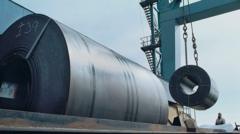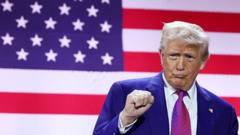This article examines the potential consequences of the US's aggressive tariff strategy on both domestic and international fronts, as companies brace for increased costs and retaliatory measures.
**Trump's Double Tariff on Metals: Implications for Industry and Trade**

**Trump's Double Tariff on Metals: Implications for Industry and Trade**
The new 50% tariffs on steel and aluminium imposed by the Trump administration incite varied reactions from businesses and trade partners.
The US has officially enacted a significant increase in tariffs on steel and aluminium imports, with President Donald Trump signing an order that raises the rate from 25% to a staggering 50%. This decision marks a pivotal moment in the ongoing trade dynamics, particularly affecting industries reliant on these metals, which are integral to sectors ranging from automotive to food packaging.
Trump asserts that these tariffs are a necessary step to safeguard the American steel industry, echoing his previous claims of national security concerns surrounding domestic production capabilities. However, this move has drawn fierce criticism from various quarters which warn of the potential for extensive backlash against US industries and the likelihood of retaliatory tariffs from affected trading partners. Hours preceding the implementation of the new tariffs, many firms expressed disbelief at Trump's determination to proceed, hoping this might be a temporary measure or a negotiating strategy.
While Trump’s policies earlier this year led to a temporary suspension of tariffs on certain allies, an exemption for the UK remains, allowing British steel exports to continue at the previously lower rate of 25%. Industry executives, like Rick Huether of Independent Can Co, have pointed out the volatility and confusion created by these tariff changes, with many businesses postponing investments and facing rising costs—compelling them to consider alternatives amid uncertainty.
Historically, the US has been the world's second-largest importer of steel, primarily sourcing it from Canada, Brazil, Mexico, and South Korea. Trump's earlier tariffs of 25% on steel and 10% on aluminium resulted in mixed impacts as various imports managed to evade duties through exemptions and trade agreements. However, with the elimination of these carving procedures, Trump is keen on reinforcing these tariffs, aiming to compel US businesses to rely solely on domestic sources.
As reported, due to the reduced imports, raw steel production in the US has remained stable through May, yet the impact of recent tariff increases is expected to lead to notable declines. Countries such as Canada and members of the European Union are already bracing for counter-measures, with trade discussions intensifying in response to the newly imposed tariffs.
In the UK, the ramifications of Trump's tariff announcement have heightened the urgency for concluding the ongoing trade negotiations with the US, with Trade Secretary Jonathan Reynolds affirming the commitment to secure beneficial terms. Notably, UK Steel’s director warned of potential catastrophic effects on exports to the US, highlighting how a 50% tariff could lead to cancellations of nearly all existing orders.
The economic implications of the tariff hikes extend beyond the steel industry, with economists projecting detrimental effects on the broader economy as manufacturing costs soar. The Tax Foundation’s Erica York emphasizes the historical context of tariff impacts on job creation, suggesting that doubling down on tariffs will provoke greater job losses in sectors reliant on steel inputs.
The sentiment among business owners is one of trepidation; Chad Bartusek from Drill Rod & Tool Steels illustrated the stark financial obstacles posed by escalated tariffs, recounting how his operational costs have surged dramatically post-announcement. As companies navigate these adjustments, many have begun to reflect on the consequences of such policies on pricing, labor, and customer orders, with the hope that stability will return swiftly to the market.
Trump asserts that these tariffs are a necessary step to safeguard the American steel industry, echoing his previous claims of national security concerns surrounding domestic production capabilities. However, this move has drawn fierce criticism from various quarters which warn of the potential for extensive backlash against US industries and the likelihood of retaliatory tariffs from affected trading partners. Hours preceding the implementation of the new tariffs, many firms expressed disbelief at Trump's determination to proceed, hoping this might be a temporary measure or a negotiating strategy.
While Trump’s policies earlier this year led to a temporary suspension of tariffs on certain allies, an exemption for the UK remains, allowing British steel exports to continue at the previously lower rate of 25%. Industry executives, like Rick Huether of Independent Can Co, have pointed out the volatility and confusion created by these tariff changes, with many businesses postponing investments and facing rising costs—compelling them to consider alternatives amid uncertainty.
Historically, the US has been the world's second-largest importer of steel, primarily sourcing it from Canada, Brazil, Mexico, and South Korea. Trump's earlier tariffs of 25% on steel and 10% on aluminium resulted in mixed impacts as various imports managed to evade duties through exemptions and trade agreements. However, with the elimination of these carving procedures, Trump is keen on reinforcing these tariffs, aiming to compel US businesses to rely solely on domestic sources.
As reported, due to the reduced imports, raw steel production in the US has remained stable through May, yet the impact of recent tariff increases is expected to lead to notable declines. Countries such as Canada and members of the European Union are already bracing for counter-measures, with trade discussions intensifying in response to the newly imposed tariffs.
In the UK, the ramifications of Trump's tariff announcement have heightened the urgency for concluding the ongoing trade negotiations with the US, with Trade Secretary Jonathan Reynolds affirming the commitment to secure beneficial terms. Notably, UK Steel’s director warned of potential catastrophic effects on exports to the US, highlighting how a 50% tariff could lead to cancellations of nearly all existing orders.
The economic implications of the tariff hikes extend beyond the steel industry, with economists projecting detrimental effects on the broader economy as manufacturing costs soar. The Tax Foundation’s Erica York emphasizes the historical context of tariff impacts on job creation, suggesting that doubling down on tariffs will provoke greater job losses in sectors reliant on steel inputs.
The sentiment among business owners is one of trepidation; Chad Bartusek from Drill Rod & Tool Steels illustrated the stark financial obstacles posed by escalated tariffs, recounting how his operational costs have surged dramatically post-announcement. As companies navigate these adjustments, many have begun to reflect on the consequences of such policies on pricing, labor, and customer orders, with the hope that stability will return swiftly to the market.





















